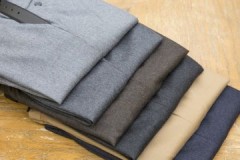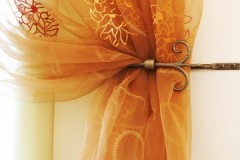Neat and balanced approach: how to iron a jacket made of different materials?
 A classic jacket is an indispensable element of a business man's wardrobe. He needs to look impeccable in order to emphasize the image and style.
A classic jacket is an indispensable element of a business man's wardrobe. He needs to look impeccable in order to emphasize the image and style.
Only a clean ironed item can create a perfect look. Cutting features and complex tailoring of the jacket require a balanced approach to smoothing.
How to iron a jacket made of various materials at home correctly, read the article.
Content
Preparation for the process
For quality ironing you need to prepare a workplace for yourself... The most convenient way to iron such a complex item is on an ironing board.
The jacket requires delicate processing, therefore it is also necessary to prepare a piece of cotton fabric through which the ironing will be carried out.
Before you start ironing, you must:
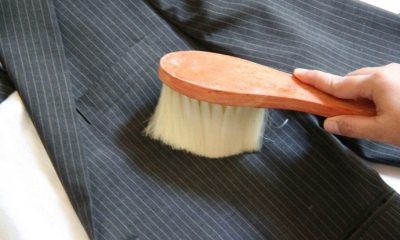 Inspect the entire item to make sure it does not require cleaning.
Inspect the entire item to make sure it does not require cleaning.- Brush the outside with a damp garment brush.
- Examine the labels on the product. This will allow you to determine the composition of the material and ironing temperature.
- Remove foreign objects from all pockets.
Additionally, it is necessary to prepare the armband that comes with the ironing board... If it is not there, you will have to gently roll a towel into a tight roller and use it as a sleeveless arm when ironing sleeves.
Not every jacket can be ironed in the usual way.
Ironing rules
Having prepared the workplace and the jacket itself, you can start ironing. The smoothing process should take place in a systematic and thorough manner, stage by stage.
Pockets
The first thing ironing begins with is pockets... To do this, turn the burlap out. Iron the pockets through a damp extra cloth.
Sleeves and shoulders
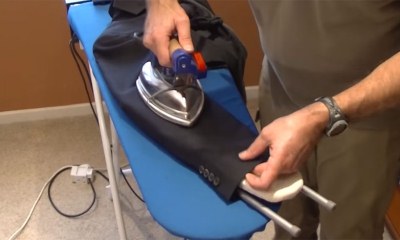 After processing, the burlap pockets are transferred to the sleeves. You need to turn them inside out... With the help of a sleeve, first one and then the second sleeve are completely ironed.
After processing, the burlap pockets are transferred to the sleeves. You need to turn them inside out... With the help of a sleeve, first one and then the second sleeve are completely ironed.
In the process of ironing, the sleeve is carefully turned so that the arrows do not smooth out and no creases form.
Pay special attention to the seam on the sleevewhen ironing, the fabric should be pulled slightly.
The shoulder area is ironed from the inside out. First, one and then the second shoulder are processed, putting it on the tapered edge of the ironing board.
Front and back
The jacket is turned inside out. Ironing on it is carried out only through a special fabric... It is necessary to move the iron very carefully so that new creases do not form.
The sides and lapels are ironed from both sides, always through additional fabric. Then the shelves and the back of the thing are completely ironed.
Gate
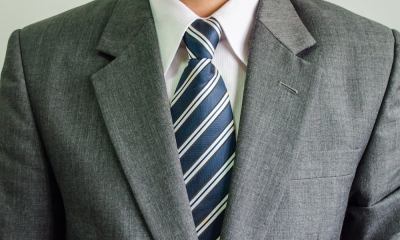 Crumpled collar is not easy to straighten... This is done only through a moistened additional fabric, moving the iron from the edges to the middle, being careful not to deform the material.
Crumpled collar is not easy to straighten... This is done only through a moistened additional fabric, moving the iron from the edges to the middle, being careful not to deform the material.
A badly wrinkled collar can be pulled slightly by hand and the steam function can be used.
A fully ironed jacket is required leave hanging for at least 30-60 minutes to completely dry and cool.
How to iron a jacket, the video will tell you:
Recommendations by fabric
A wide variety of fabrics and combinations can be used for sewing. There are no differences in ironing of classic male and female models.
Wool
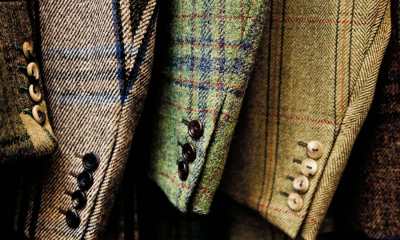 Ironing is carried out at the temperature of "wool" or "silk" with great care... Wool from inept handling can stretch or, conversely, shrink. To prevent this from happening, the iron must not be moved over the fabric with force.
Ironing is carried out at the temperature of "wool" or "silk" with great care... Wool from inept handling can stretch or, conversely, shrink. To prevent this from happening, the iron must not be moved over the fabric with force.
It is best to carry out the processing in small areas, applying and then removing the iron. In this case, the woolen fabric should be practically dry at the end of ironing.
Also, the processing depends on the percentage of natural fibers in mixed fabrics: the more there are, the more accurate the iron should be.
Thick woolen fabrics on warm garments may have nap... This circumstance must be taken into account when ironing, since the iron must move in the direction of the pile.
The plasticity and pliability of wool allows it to stretch a little at the stage of ironing, if it shrinks after washing.
Linen and cotton
Natural fabrics do not iron well when dry... In this regard, they should be smoothed either not completely dry, or pre-moistened with a spray bottle. Such a jacket is ironed from the inside using steam.
Some types of linen fabrics are forbidden to iron, this should be indicated on the label. A slight bruise of such a thing will have its own special charm.
Synthetics
When ironing polyester or other synthetic fabric it is necessary to turn off the steam function on the iron and set the minimum temperature mode.
Synthetics practically do not wrinkle, so proper storage allows you to always have a neat, even jacket without additional ironing.
Silk
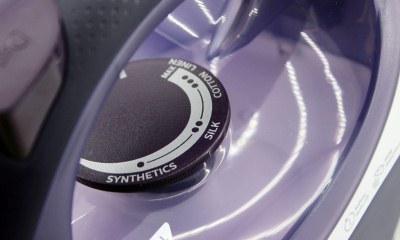 Silk can be natural or artificial... Natural silk jackets are not ironed. Artificial - processed taking into account the recommendations on the tag from the inside of the product.
Silk can be natural or artificial... Natural silk jackets are not ironed. Artificial - processed taking into account the recommendations on the tag from the inside of the product.
This is a very demanding material, it needs careful handling and delicate smoothing at the "silk" temperature.
When ironing silk it is necessary not only to adhere to the temperature regime suitable for the fabric, but also not to keep the iron in one place for a long time.
Leather
Leather jacket smoothen only through additional cloth or kraft paperwithout holding the iron in one place for a long time.
If possible, a product made of soft leather it's better to just leave it hanging on a hanger for a few days... He will straighten under his own weight. How to iron leather products can be found in this articles.
Velveteen
It is possible to iron a corduroy jacket only under the following conditions:
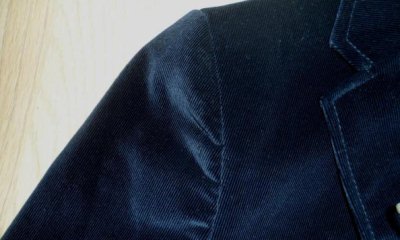 from the seamy side;
from the seamy side;- considering the direction of the pile;
- do not handle completely dry or completely wet fabric;
- do not press the iron with force;
- do not spray water from the front of the jacket;
- use the steaming function on the iron, or even better - the use of an uninterrupted steam supply.
You can iron such a jacket on a board only by placing a terry towel under the front side of the material. Otherwise, the pile may be damaged.
It is advisable to smooth a thing made of this material with a steamer., as using an iron may damage the texture of the material.
Alternative ways
Lack of an iron is not a reason to panic or wear a wrinkled item.
To cope with smoothing will help:
- folk recipes,
- the use of household appliances such as a steamer and a steam generator.
Steam generator and steamer
 Having a steamer will help smooth the jacket even faster than using an iron. For this, the product is freely suspended on a hanger. Treatment with a steamer is carried out in zones, moving the working nozzle from top to bottom.
Having a steamer will help smooth the jacket even faster than using an iron. For this, the product is freely suspended on a hanger. Treatment with a steamer is carried out in zones, moving the working nozzle from top to bottom.
This method of straightening the jacket does not require the use of other tools and is even more efficient than ironing.
The steam generator provides the effect of steam on the fabric... In this case, the type of material must be taken into account. For leather items, direct contact with the surface of the device is unacceptable, and should be about 15 cm.
Traditional methods
One of the easiest ways to straighten your jacket is to hold it over a steam bath. To do this, very hot water is taken into the bath.
After that, the clothes are outweighed in a dry place and left on the hangers to dry.... After some time, this method of straightening the jacket can be repeated.
For more information on how to iron clothes without using an iron, see here.
Recommendations
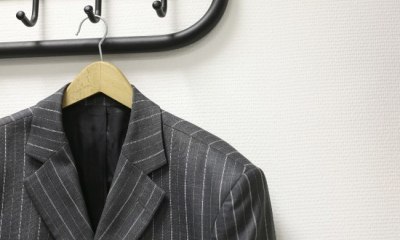 Simple tips will help you iron such a complex thing as a jacket with high quality.
Simple tips will help you iron such a complex thing as a jacket with high quality.
These recommendations include:
- Do not set the temperature on the iron higher than indicated on the label for the product.
- The fabric through which the jacket is ironed must be carefully wrung out.
- During ironing, you should carefully bypass the buttons so that they do not come into contact with the hot soleplate of the iron.
It is important to choose the optimal temperature mode for ironing, since if insufficient, the folds will not be smoothed out, and if too much, the probability of damage to the thing increases.
Useful video
Watch a video on how to smooth out folds on a suit jacket and trousers:
Conclusion
A jacket is a difficult-to-maintain wardrobe item, the care of which includes proper storage and high-quality ironing.
It should be ironed only if necessary, taking into account the peculiarities of the material of manufacture and the nuances of the cut.

